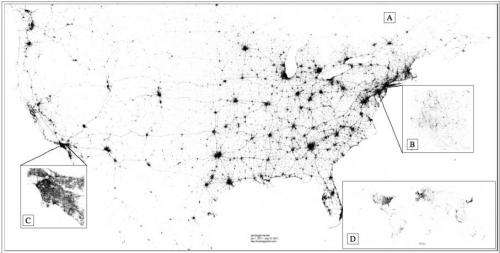Each point corresponds to a geolocated tweet posted in 2011. Twitter activity is most apparent in urban areas. Note that the image contains no cartographic borders, simply a small dot for each message. Legend: A (U.S.), B (Washington, D.C.), C (Los Angeles, C.A.), and D (Earth). Credit: arXiv:1304.1296
(Phys.org) —A new mathematical analysis of Twitter messages has shown that happiness indicators increase logarithmically with distance from home, and that people who move around more are likely to be happier than those who stay close to home.
A team from the Computational Story Lab at the Department of Mathematics and Statistics at the University of Vermont studied data of 37 million "tweets" made by 180,000 users of Twitter in the U.S. during 2011, and looked at indicators of happiness in the messages. The messages selected were from tweeters using an opt-in mobile phone app that uses GPS to report their exact latitude and longitude. The analysis showed a clear positive correlation between the use of positive words (such as happy, great and new) and the distance from users' most usual locations.
The scientists, Chris Danforth and colleagues, used a sentiment analysis instrument called a hedonometer to analyze the data, and used an established scale that gives words a score for their negative or positive sentiments. The positive words included great, happy, new, good, lol, love, resort, lunch, cafe, hahaha, and beach. Negative words included hate, never, mad, no, don't, and can't.
They then analyzed the tweets in relation to the geographic location. They found that most users tweeted from two main locations, which the scientists called work and home habitats. They also calculated the distance in kilometers from the users' normal geolocations for each tweet, and determined the size of the area they moved around in, which they term the "user radius of gyration."
The results showed that people in cities tend to have a larger radius of gyration than those in less urban areas, which was unexpected as it seemed more likely that people outside of cities would travel greater distances by necessity. The study also found that "large radius" people are more likely to tweet from the main downtown areas of cities than small radius people.
Previous studies have shown that happiness indicators rise with socioeconomic advantage, and the new study adds weight to those findings, since people who are traveling and tweeting happily as they go are more likely to be better off. Happiness indicators have also previously been positively correlated with being married and negatively correlated with obesity.
When a long way from home, words such as cafe, restaurant, and food were more likely to be included in tweets, and messages frequently referred to meals, but these long-distance users were less likely to indicate laughing. Some positive words were more associated with being at home, such as love, hahaha, and lol, but the frequency of negative words was much higher when closer to home than at a great distance. The least happy words were found in messages sent from a distance representative of a short commute to work. Past this distance the relationship between happiness indicators and both distance and radius of gyration was logarithmic.
Larger radius users were more likely to express laughter (hahaha and similar terms)than those with a smaller radius of gyration, and the frequency of negative words in their tweets was much lower.
Since the analysis was done automatically by the hedonometer, some of the messages could be incorrectly classified as happy because the instrument had no way of identifying sarcasm or other emotional aspects of the message. Expressing happiness is also not the same as actually being happy. There might be a tendency to tweet more when on vacation or doing something novel, but the researchers selected users who geotagged over 300 messages during the year, which suggests they tweeted as a normal activity rather than something they only do when on vacation.
The Vermont researchers suggest that analyses of real-time data from tweets can tell us a great deal about our culture that cannot be captured by other means such as surveys, and could provide useful feedback for social planners and public health campaigns.
More information: Happiness and the Patterns of Life: A Study of Geolocated Tweets, arXiv:1304.1296 [physics.soc-ph] arxiv.org/abs/1304.1296
Abstract
The patterns of life exhibited by large populations have been described and modeled both as a basic science exercise and for a range of applied goals such as reducing automotive congestion, improving disaster response, and even predicting the location of individuals. However, these studies previously had limited access to conversation content, rendering changes in expression as a function of movement invisible. In addition, they typically use the communication between a mobile phone and its nearest antenna tower to infer position, limiting the spatial resolution of the data to the geographical region serviced by each cellphone tower. We use a collection of 37 million geolocated tweets to characterize the movement patterns of 180,000 individuals, taking advantage of several orders of magnitude of increased spatial accuracy relative to previous work. Employing the recently developed sentiment analysis instrument known as the textit{hedonometer}, we characterize changes in word usage as a function of movement, and find that expressed happiness increases logarithmically with distance from an individual's average location.
via Arxiv Blog
© 2013 Phys.org























